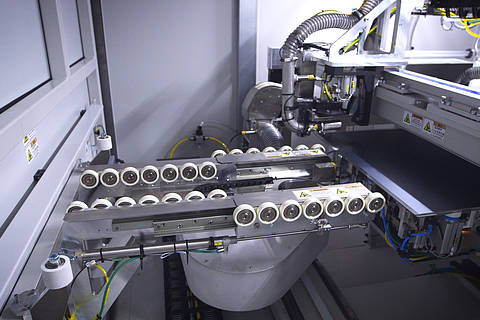CIGS Backend Processing
The combination of laser and mechanical processing creates reliable long-lifetime CIGS thin-film solar modules, comprising:
- Mechanical-tool based molybdenum exposure to provide a clean the surface for the electrical back electrode connection
- Laser edge deletion (LED) based on large spot laser ablation to prepare the module for the hermetic sealing
- Glass drilling based on laser ablative drilling to provide through-holes to connect the module’s front and back electrode with the junction box
Molybdenum removal to expose the CIGS-module's back electrode
During the production of CIGS thin-film solar modules the molybdenum layer covering the glass has to be exposed in the area of the photodiode’s respectively solar modules back electrode along an area parallel to the long glass edge for the subsequent welding or conductive gluing of conductive ribbons.
This requires the selective removal of the only a few micron thick layer stack of a CIGS absorber and the transparent front electrode (TCO) without damaging the molybdenum layer underneath. This is reliably achieved by mechanical means.
Clean and undamaged glass surface achieved by 4JET’s laser edge deletion process (LED)
Laser edge deletion (LED) is a contactless process to remove the complete CIGS layer stack from the edges of the solar module to provide an electrical isolation and prepare the glass edge for the hermetic sealing process of the module, without damaging the glass, of course.
Edge deletion is achieved by laser ablation, whereby a large laser spot with homogeneous intensity distribution (top-hat profile) structures from the glass side. To achieve the required throughput, the laser ablation head is moved in a continuous motion along the glass edge while a 2D scanner scans the laser spot at very high speed (on-the-fly patterning). By using a glass-side laser ablation process, ablation rates of up to 50 cm²/s and more are possible, which is essential for the required line throughput and means low production costs. Furthermore, the glass-side laser ablation eliminates the risk of melting and thus the formation of short circuits at the edges of the layer stack. Furthermore, the ablation process leaves a clean, undamaged glass surface, which contributes to the production of reliable, durable CIGS modules..
4JET’s laser edge deletion (LED) provides:
- electrical isolation resistance > 1 GOhm
- ablation rates up to 50 cm²/ s and more
- highest productivity
In contrast to conventional mechanical drilling, laser glass drilling enables a contactless and dry process that minimizes the chipping within the hole. No reworking of the hole edges is necessary. This is a necessary prerequisite for high reliability and durability of CIGS solar modules.
Further advantages are not only the high process stability and reproducibility, but also the high flexibility. In addition to the typical round holes, the software allows the application of different hole geometries.
4JET's solution for high-quality CIGS thin-film solar modules
Get to know our unique MPCT - it integrates all three described back-end processes in one machine to produce reliable, durable CIGS modules at low production costs.
Contact
We look forward to your questions – our experts are at your disposal.

















































